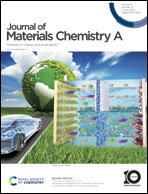Block copolymer micelles as efficient colloidal photosensitizers in the light-driven hydrogen evolution reaction†
Abstract
Light-driven hydrogen evolution is a key process in the development of sustainable energy schemes. Here we report the covalent embedding of molecular ruthenium (II) photosensitizers within block copolymer micelles. These colloids were used to conduct light-driven catalysis with outstanding performance using molecularly dissolved thiomolybdate clusters as hydrogen evolution reaction (HER) catalysts. The preparation of polystyrene-block-poly((3-chloro-2-hydroxypropyl methacrylate)-co-(4-methoxymethylstyrene)) (PS-b-P(ClHPMA-co-MMS)) and polystyrene-block-poly((2-hydroxy-3-((3-(4′-methyl-(2,2′-bipyridine)-4-yl)propyl)amino)propyl methacrylate)-co-(4-methoxymethylstyrene)) (PS-b-P(bpyHPMA-co-MMS)) block copolymers marks the first step to achieve these colloidal nanoreactors. Therefore, after synthesis using nitroxide-mediated polymerization, the resulting PS-b-P(ClHPMA-co-MMS) block copolymer was functionalized by nucleophilic substitution of the side chain chlorine moieties with a primary amine bearing 2,2′-bipyridine. These motifs then acted as ligands for the covalent attachment of a ruthenium (II) polypyridyl complex to the block copolymer architecture. Afterwards, [Ru]-functionalized block copolymer micelles, obtained by self-assembly in methanol, were tested as colloidal photosensitizers for the [Mo3S13]2−-catalyzed hydrogen evolution reaction. Initial experiments showed that under comparable reaction conditions, the colloidal system outperformed the homogeneous reference.



 Please wait while we load your content...
Please wait while we load your content...